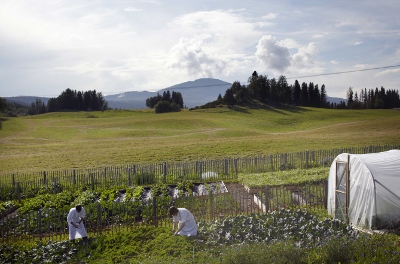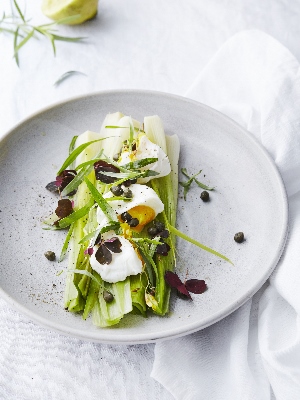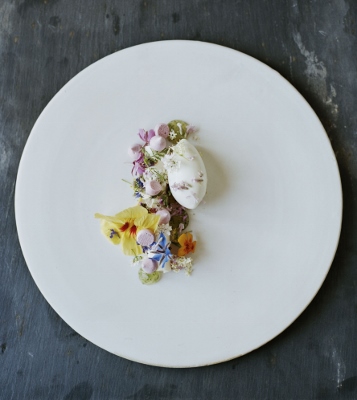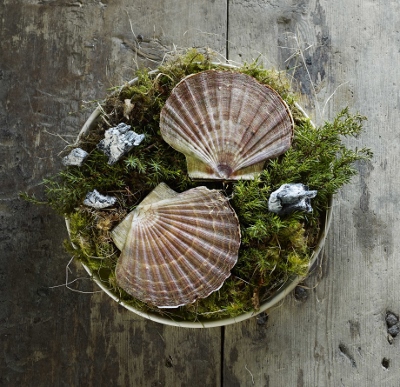Image from Noma : © Ditte Isager / courtesy of Phaidon
I recently mentioned to a friend that I was working on an article about New Nordic cuisine. “Fermented shark meat?” he replied.
A few years ago, that challenging ingredient and others like it were what most people knew about the food culture of the Nordic countries. But today Noma, René Redzepi’s celebrated restaurant in Copenhagen, is again at the top of the Restaurant list of the 50 best restaurants in the world and countries like Denmark, Sweden, and Iceland have become must-visit destinations for gastro-tourists. We’ve long known that the Nordic countries offer beautiful scenery, liveable cities, and an impeccable sense of design. Now the world has woken up to the fact that they have great food too.
How did this happen over the course of a few short years? The story involves a manifesto, a pan-government program, and forward-thinking chefs who helped their people realize the potential they had just outside their doors.
The Manifesto

Image from Fäviken: © Erik Olssen / courtesy of Phaidon
Chefs René Redzepi and Claus Meyer opened Noma—the name is a portmanteau of the Danish words nordisk (Nordic) and mad (food)—in 2003, serving a fine-dining, modern reinterpretation of traditional Nordic cuisine. (Meyer has since moved on.) Together with some of the region’s greatest chefs, the two put together the “Manifesto for the New Nordic Cuisine”, calling for the embrace of traditional Nordic foods and methods of production and preservation. “As Nordic chefs we find that the time has now come for us to create a New Nordic Kitchen,” the manifesto reads, “which in virtue of its good taste and special character compares favourable with the standard of the greatest kitchens of the world.”
The aim was to promote the Nordic culinary traditions methods that were still well known, such as the smoking of seafood, and those that were underappreciated or in danger of being lost. The manifesto advocated for attention to the seasons and the use of fresh, local ingredients from regional producers instead of a reliance on imported goods. The next year, the New Nordic manifesto was adopted by the Nordic Council of Ministers as the guidepost for the New Nordic Food Programme, which involves Iceland, Sweden, Finland, Norway, Denmark, Greenland, the Faroe Islands, and the Åland Islands.
In the beginning of all this the idea was simply to get Nordic countries on the culinary map, said Gunnar Karl Gíslason, the chef/owner of Dill Reykjavik, Iceland. Though the manifesto and the beginnings of the Nordic culinary explosion started with fine-dining restaurants like Noma, the umbrella of “New Nordic” now includes everything from a restaurant hailed as the best in the world to local cafes and gastropubs. For Gíslason himself, opening Dill was not about doing something specifically New Nordic—rather, it was a chance to explore and cook with the old Icelandic traditions, using local products and methods in a modern way.
“We are rediscovering our old traditions and trying to put them back on the map,” he said.
The Ingredients
Danish writer and chef Mette Helbæk’s own love affair with New Nordic began around the same time she met her husband, while working in his restaurant during university. “I just saw all these amazing ingredients and I was hooked,” Helbæk said.
Today that passion informs her work as a food writer and a chef/owner of Stedsans in Frederiksberg with her husband Flemming. “It just makes sense to me to be able to look outside my window and cook what’s in my garden,” she said. These fresh ingredients simply taste better, she said, and her work now focuses primarily on vegetables—something that may seem surprising given the cold climate in which she lives.
photo by Stine Christiansen
That cold is part of what makes particular foods from the Nordic regions so delicious. Shellfish like mussels and langostines that come from colder waters have a natural sweetness not found in those plucked from waters further south, and fish from the North Atlantic are particularly good sources of omega-3 fatty acids. Dairy from the region is notably rich, and there’s a natural tartness to the berries that grow in colder climates that both works with the acidity present in much of the Nordic kitchen’s offerings and compliments a cuisine that is less reliant on sugar, even in desserts, that we may be used to in North America.
The ingredients that inspire Helbæk and other New Nordic chefs are more varied that one might suspect, given that they come from the northern reaches of the globe. They include:
?Fish: Trout, monkfish, cod, char
?Shellfish: Langoustines, mussels, scallops, urchin
?Berries: Blueberries, cloudberries, lingonberries, raspberries
?Vegetables and grains: Carrots, cabbage, beets, barley, rye
?Herbs and wild plants: Caraway, yarrow, juniper, sorrel, chanterelles, lichen
?Wild game: Wild birds, hare, deer
?Dairy: Yogurt, cheese, cream, butter
?Meat: Cows, sheep, pigs, poultry, goats
Foraging is another way for those in Nordic countries to rediscover what they have available outside their doors. “The wild and locally sourced products are special because they are not accessible to everybody—you have to know where to go and invest some time to get it, not necessarily money,” Helbæk said. “The not-so-easily-accessible has always been a luxury. In our region, right now it means that the biodynamic carrot from Kiselgården in Ringsted, one hour’s drive away from Copenhagen, the sea-buckthorn you picked on a hike, or the ramson that you planted in your garden last spring is worth more than the thousand-dollar caviar flown in.”
It’s true that many of the ingredients that are key to New Nordic cuisine have a short growing season. All local eating is tied to seasonality, but this may be truer in northern climates than it is anywhere else. That limitation can be frustrating: when you’ve got access to wild blueberries and mussels made sweet by the cold waters, wouldn’t you want to be able to eat them year-round? At the same time, it can add something special to your meals when you’re anticipating a key ingredient’s return for much of the year.
“You really change completely your way of eating from one month to another,” Emilia Terragni, publisher at Phaidon, said of local eating in Nordic countries—and there is some joy in that anticipation of the return of a favorite ingredient. “You just enjoy it more because you know it’s limited.”
The Methods
That scarcity can breed innovation, Helbæk said, and that appears to be exactly what it has done for the chefs most heralded as leaders of the New Nordic movement. Centuries ago, Nordic people perfected a variety of food preservation techniques in order to get them through the months when fresh ingredients were scarce. Today’s chefs are rediscovering those techniques, using them both in the traditional ways and reworking them to modern ends.
So yes, if you go to Iceland you’ll find fermented shark—it’s called hákarl and it’s served at the Icelandic midwinter festival of þorrablót—but you’ll also find preserved foods in the Nordic countries that are legitimately delicious. They include smoking, curing, drying, and fermenting meat; salting and drying fish and seafood; and pickling, canning, clamping, fermenting, drying, and pasteurizing produce.
The success of the New Nordic kitchen has helped producers working with traditional methods stay in business. Food writer and cookbook author Jody Eddy first visited Iceland shortly after the country’s financial collapse in 2008. Gíslason, with whom Eddy cowrote the cookbook North, was set to open Dill when several of his investors pulled out overnight because of the collapse, requiring him to push forward on his own.

Image from Noma : © Ditte Isager / courtesy of Phaidon
The financial crisis is part of what pushed the New Nordic kitchen forward in that country, Eddy said. Because of the collapse and the drop in value of Iceland’s currency, chefs like Gíslason were forced to look internally for ingredients for their restaurants, leading to a rediscovery of producers who had been somewhat forgotten.
Eddy gives the example of blue mussels, an Icelandic ingredient that wasn’t often served in restaurants before Dill requested them. “All of a sudden, blue mussels are the thing,” she said, and Gíslason’s initial harvester now supplies them to Noma in Copenhagen.
That kind of collaboration, with countries sharing ingredients and chefs working together, is a hallmark of New Nordic cuisine. Eddy gives the example of a salt producer profiled in North, Icelandic Flake, using Iceland’s geothermal energy in salt production—something that used to be done for the king of Denmark, which formerly colonized the country. More recently, she saw chef Christian F. Puglisi of Relæ manifest/ in Copenhagen talk with Bjorn Steinar Jonsson of Icelandic Flake and ask him when he’ll be getting more of his salt. It’s a pretty remarkable thing to see when you consider how the production of that ingredient has shifted, she said, and what the relationship between the two countries once was.
The Future
But on top of the fascinating cultural background of the rise of New Nordic cuisine, it also simply tastes good. Book publisher Phaidon is a proponent of the cuisine, publishing two books by Redzepi (Noma and A Work In Progress) and Fäviken by Magnus Nilsson, head chef of the Swedish restaurant of the same name. Nilsson is also at work on a New Nordic “food bible” for the publisher, due out in the fall.
“The most important thing is that this food is really delicious,” Terragni of Phaidon said of the publisher’s interest in the New Nordic kitchen. The cuisine’s fresh, healthy, modern style fits the bill there, she said, as does its interesting combination of flavors. “There is a strong acidity in the flavors that I think is a very new thing,” she said.
But the popularity of the cuisine (Terragni reports that the Nordic-focused cookbooks have done very well for Phaidon) goes beyond simply the recipes themselves. What is special about chefs like Redzepi, she said, is not just the food but the methods used to prepare it, and the attitudes around it. For example, the famed Nordic aesthetic finds its way into the food itself, including a skill with texture. “They have this ability of doing very beautiful things in a simple way,” she said.
Though the New Nordic kitchen is deeply tied to place, Helbæk thinks that part of its wider appeal comes from the way its meaning resonates with people around the globe. “I think that everyone is just looking for something meaningful,” she said, “and there is something very meaningful about a group of countries saying ‘We want to know what is real here.’”
That sense of place is something that can be implemented anywhere, Eddy said. “It’s not just about using the ingredients,” she said. “I do think what’s happening on a grander scale won’t just go away.” She gave the example of the MAD conference, started by Redzepi, which looks at a variety of topics around food and how it ties with other aspects of culture and society. Similar conferences have now sprouted up around the world, she said, including Mesamérica in Mexico City. “What that represents is how those ripples are trickling out from it,” Eddy said.
Much as there is no one meal or ingredient that comes to mind when we talk about Italian food, Gíslason thinks the future of the New Nordic kitchen comes in the increasing refining of the local ingredients and traditions and a more segmented exploration of the culinary culture they come from. “I just think that what will happen next is that restaurants that are truly into it will just start digging deeper and deeper into their roots,” Gíslason said.

Image from Fäviken: © Erik Olssen / courtesy of Phaidon
Essential Cookbooks
Noma by René Redzepi
A Work In Progress by René Redzepi
North by Gunnar Karl Gíslason and Jody Eddy
Relæ by Christian F. Puglisi
Fäviken by Magnus Nilsson
Essential Eateries
Noma (Copenhagen, Denmark)
Dill (Reykjavik, Iceland)
Fäviken ärpen, Sweden)
Maaemo (Oslo, Norway)
Restaurant Frantzén (Stockholm, Sweden)
Geranium (Copenhagen, Denmark)
Relæ , Denmark)
Olo (Helsinki, Finland)
Terri Coles is a freelance writer living in St. John’s, Newfoundland. She’s a recovering picky eater.